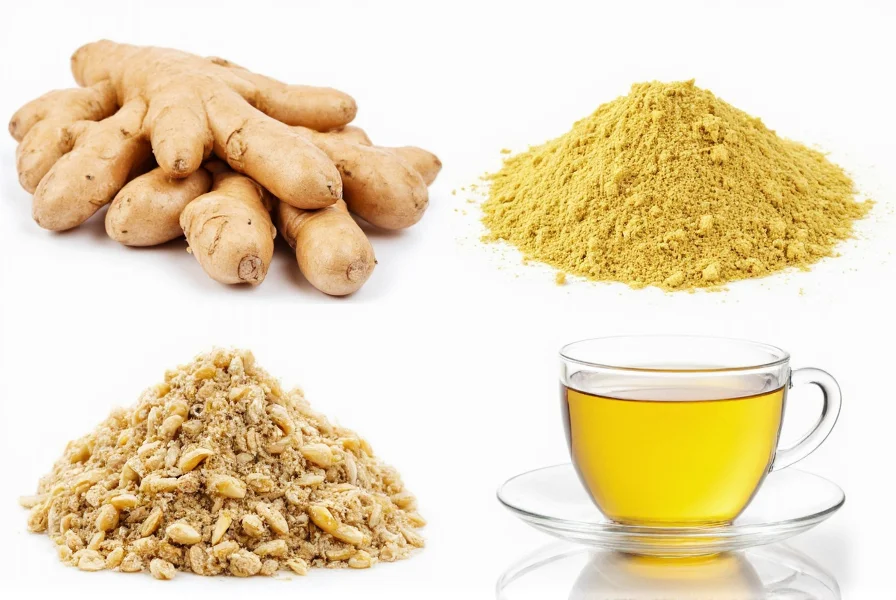Ginger has been valued across cultures for millennia not just as a culinary spice but as a medicinal powerhouse. Modern science continues to validate many traditional uses while uncovering new therapeutic potentials of this remarkable rhizome. Let's explore the comprehensive properties that make ginger a staple in both kitchens and medicine cabinets worldwide.
Chemical Composition of Ginger
Ginger's complex chemical profile includes more than 400 identified compounds that contribute to its distinctive flavor, aroma, and therapeutic properties. The most significant bioactive components fall into several categories:
| Compound Category | Primary Components | Concentration in Fresh Ginger | Key Characteristics |
|---|---|---|---|
| Gingerols | 6-gingerol, 8-gingerol, 10-gingerol | 0.5-1.5% | Responsible for pungency, anti-inflammatory, antioxidant |
| Shogaols | 6-shogaol, 8-shogaol, 10-shogaol | Trace-0.3% | Formed when gingerols dehydrate, more potent anti-nausea effects |
| Zingerone | Zingerone | 0.1-0.3% | Milder pungency, formed when ginger is cooked |
| Terpenes | Zingiberene, β-bisabolene | 0.5-1.0% | Contribute to aroma, potential anticancer properties |
The specific composition varies based on growing conditions, harvest time, and processing methods. Fresh ginger contains predominantly gingerols, while dried or cooked ginger develops higher concentrations of shogaols through thermal degradation, which actually increases certain medicinal properties.

Medicinal Properties and Health Benefits
Ginger's therapeutic properties have been extensively studied, with scientific evidence supporting many traditional uses. The most well-documented medicinal properties include:
Nausea and Vomiting Relief
Ginger demonstrates significant antiemetic properties, making it effective for various types of nausea. Multiple clinical trials show that 1-1.5 grams of ginger powder significantly reduces nausea and vomiting in:
- Pregnancy-related morning sickness (without adverse effects on pregnancy outcomes)
- Post-operative nausea
- Chemotherapy-induced nausea
- Motion sickness
The mechanism involves modulation of serotonin receptors in the gastrointestinal tract and central nervous system, plus acceleration of gastric emptying.
Anti-Inflammatory Effects
Ginger compounds, particularly 6-gingerol, inhibit key inflammatory pathways including COX-2, LOX, and various cytokines. Research published in the Journal of Medicinal Food demonstrated that ginger extract reduced markers of inflammation by 29% in osteoarthritis patients after 6 weeks of treatment with 500mg twice daily.
Digestive Enhancement
Ginger stimulates digestive enzymes and accelerates gastric emptying. A study in European Journal of Gastroenterology & Hepatology found that ginger increased gastric emptying rate by 25% compared to placebo, which explains its traditional use for indigestion and bloating.
Nutritional Profile of Ginger
While typically consumed in small quantities, ginger contributes valuable nutrients. One tablespoon (about 6 grams) of fresh grated ginger provides:
- 2 calories
- 0.1g protein
- 0.4g carbohydrates
- 0.1g fiber
- 1% of daily manganese
- Trace amounts of potassium, magnesium, and vitamin B6
Though not a significant source of macronutrients, ginger's value lies in its concentration of bioactive compounds rather than basic nutrition. The therapeutic effects come from these compounds, not from substantial vitamin or mineral content.
Traditional Uses Across Cultures
Ginger's properties have been recognized globally for centuries:
- Ayurvedic Medicine: Used as a "universal remedy" for digestive issues, respiratory conditions, and as a warming agent
- Traditional Chinese Medicine: Employed to treat colds, flu, and digestive disturbances, particularly for "cold" conditions
- Japanese Practice: Incorporated in pickled form (gari) to cleanse the palate between sushi courses and aid digestion
- European Herbalism: Historically used for nausea, especially during sea voyages
- African Traditional Medicine: Applied for pain relief and as an antimicrobial agent

Scientific Research on Ginger Properties
Recent research continues to validate and expand our understanding of ginger's properties:
Pain Management
A 2021 meta-analysis in Pain Medicine reviewed 14 clinical trials and concluded that ginger supplementation significantly reduced pain intensity in osteoarthritis patients compared to placebo, with effects becoming noticeable after 4-6 weeks of regular use.
Metabolic Health
Studies indicate ginger may improve insulin sensitivity and reduce fasting blood sugar. Research in Nutrition Research showed that 2 grams of ginger powder daily for 12 weeks reduced fasting blood sugar by 12% in type 2 diabetes patients.
Antimicrobial Activity
Ginger extracts demonstrate inhibitory effects against various bacteria including E. coli and Salmonella, as well as certain fungi. The compounds responsible appear to disrupt microbial cell membranes.
Practical Applications and Dosage
To maximize ginger's beneficial properties, consider these evidence-based recommendations:
- For nausea: 1-1.5 grams of fresh ginger or 250-500mg of standardized extract 30-60 minutes before potential nausea triggers
- For inflammation/pain: 1-2 grams of fresh ginger daily or 300-400mg of extract twice daily
- For digestive support: 2 grams of fresh ginger 15-30 minutes before meals
Consumption methods affect bioavailability: fresh ginger provides gingerols, while dried or cooked ginger offers higher shogaol content which may be more effective for certain conditions.
Safety Considerations and Potential Interactions
Ginger is generally recognized as safe (GRAS) by the FDA when consumed in typical food amounts. However, some considerations include:
- May increase bleeding risk when combined with anticoagulants like warfarin
- Could lower blood sugar excessively when taken with diabetes medications
- High doses (over 4 grams daily) may cause heartburn or mouth irritation
- Generally safe during pregnancy for nausea relief but consult with healthcare provider
Individuals with gallstones should consult a physician before using therapeutic doses, as ginger may increase bile production.
Conclusion
Ginger's remarkable properties stem from its complex chemical composition, particularly the gingerol family of compounds that provide anti-inflammatory, antioxidant, and digestive benefits. Modern research continues to validate traditional uses while uncovering new therapeutic applications. When incorporated appropriately into daily routines, ginger offers a natural approach to supporting digestive health, managing inflammation, and addressing nausea without significant side effects for most people. Understanding the specific properties of ginger allows for targeted use based on individual health needs and goals.











 浙公网安备
33010002000092号
浙公网安备
33010002000092号 浙B2-20120091-4
浙B2-20120091-4